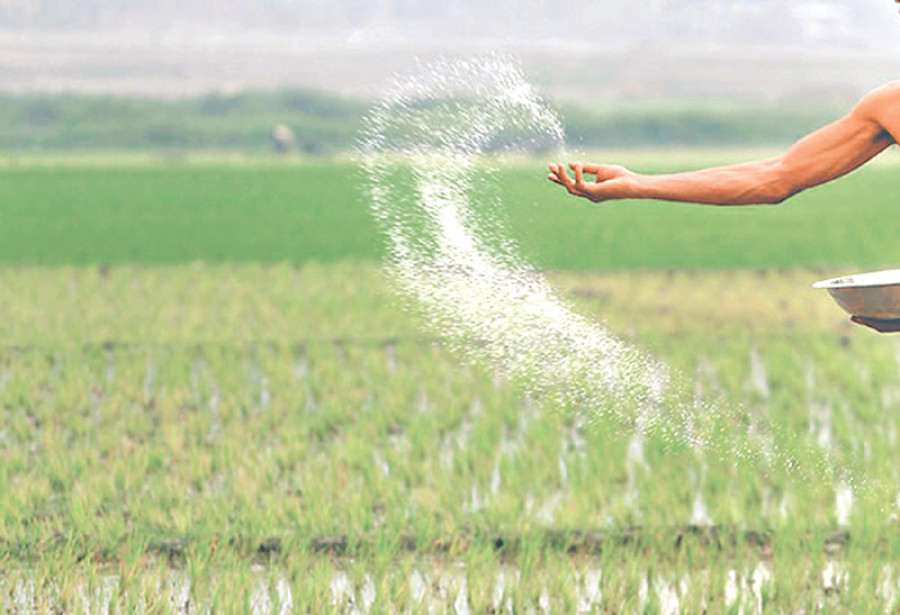Opinion
Help the Nepali farmer
An efficient chemical fertiliser supply system is needed to end recurrent shortages
Nanu Jha
We need to fortify the soil if we want to maintain fertility and increase agricultural yield. Most chemical fertilisers contain three basic plant nutrients—nitrogen, phosphorus and potassium. Consumption of chemical fertilisers in Nepal was recorded at 75.11kg per hectare in 2014-15, which is very low compared to 400kg in China, 200kg in Bangladesh and 150kg in India among neighbouring countries. The government established Agriculture Inputs Corporation (AIC) in 1966 and tasked it with procuring, storing and distributing fertilisers. An order cycle lasts four to five months, and it is not certain that the shipment will arrive in time for the planting season.
In the mid-1990s, the government began cutting back on financial backing for the agricultural sector in line with shrinking donor support in the name of economic liberalisation. In 1997, the government deregulated the fertiliser trade, removed price subsidies and allowed the private sector to import and distribute fertilisers. After deregulation, the government realised the need for a quality control system and promulgated Fertiliser (Control) Order, 1997 under the Essential Commodity Control (Rights) Act, 1961. A Fertiliser Guideline was drawn up in 1999 to facilitate the implementation of the order. AIC was also dissolved and two new companies were formed to replace it—Agriculture Inputs Company to deal with fertilisers and National Seed Company to deal with seeds.
Incentive for production
Deregulation ended the monopoly of AIC and private firms entered the fertiliser trade. Nevertheless, the country continued to experience disruptions in supplies due to fluctuating world prices, leading to a decline in confidence in the private sector. Deregulation largely failed to improve the supply of fertilisers as expected. High prices put fertilisers beyond the reach of small and marginal farmers, and they began buying cheaper products of dubious quality. At the same time, high production costs made domestic products uncompetitive. Nepal farmers were operating in an extremely adverse situation without any incentive for production. In many cases, they could hardly recover the cost of production.
After this issue was raised by politicians, civil society and different organisations, the government decided in 2009 to supply fertilisers at cost price, and formed the Fertiliser Supply and Distribution Management Committee headed by the respective chief district officer. The government has been distributing fertilisers at a concessionary rate to small and marginal farmers. AIC and Salt Trading Corporation (STC) are engaged in marketing subsidised fertilisers. They are distributed to farmers through cooperatives and private dealers.
There are a number of private companies engaged in the fertiliser business. They import subsidised fertilisers from India and distribute them through local agro-business dealers or shops in rural areas of the Tarai. There are no reliable statistics about the informal inflow of fertilisers from India. Subsidised fertilisers fulfil about 35 percent of the total requirement, and the rest is met by contraband brought through the porous Indian border. Fertiliser shortages during the peak planting season is a chronic problem, and the government has been unable to create an effective nationwide supply mechanism. AIC and STC are also unable to distribute fertilisers efficiently across the country due to their limited networks.
A bumper harvest
The rising burden of subsidising fertilisers on the government has caused considerable concern. But a reduction in subsidies could have an adverse effect on fertiliser use if not counter-balanced by other factors. This represents a real challenge for the government, experts and the Agriculture Ministry. In Brazil, withdrawal of subsidies brought a positive response in terms of fertiliser use as it was compensated by satisfactory minimum prices for farm products. If the fertiliser subsidy programme is going to be continued for a long time, it will be good to implement a voucher system as desired by farmers. Under this scheme, the subsidy amount is directly deposited into their bank accounts, and they can buy fertilisers from the open market.
If this system is implemented, the private sector will also be involved in fertiliser marketing. Both private and public sectors need to be involved in the fertiliser business to ensure lower costs and availability of fertilisers when required. No doubt, this system can improve fertiliser supplies across the country, provided an effective quality control and monitoring mechanism is established. Our open border with India could be both a challenge and an opportunity. Formalisation of trade with India would enhance quality fertiliser supplies and, to some extent, it can play a pivotal role in stabilising fertiliser prices. It is also suggested that farmers procure fertilisers from reliable sources and use them in the recommended dose for efficient nutrients uptake by crop plants for a bumper harvest.
Jha is an agricultural economist and adjunct professor at Himalayan College Agricultural Sciences and Technology, Kathmandu




 10.12°C Kathmandu
10.12°C Kathmandu










